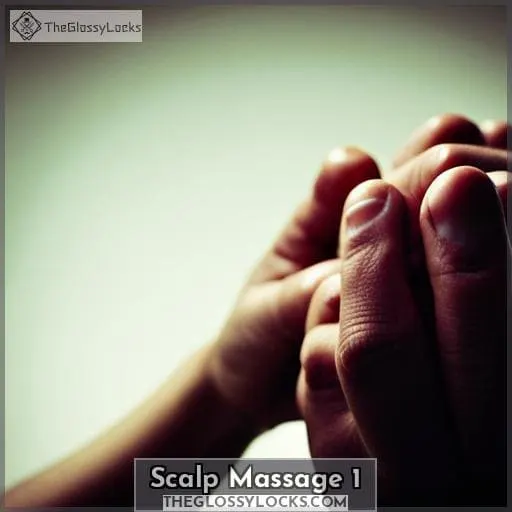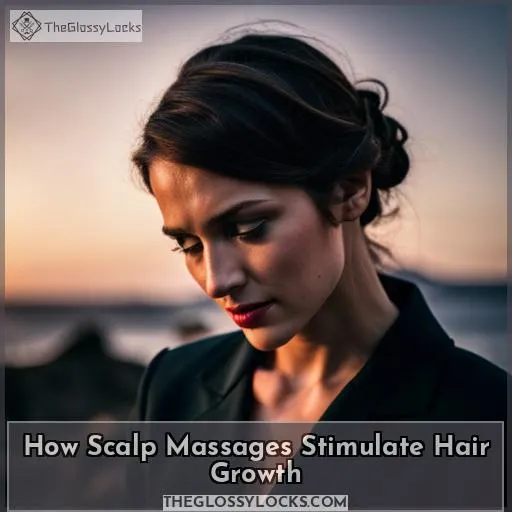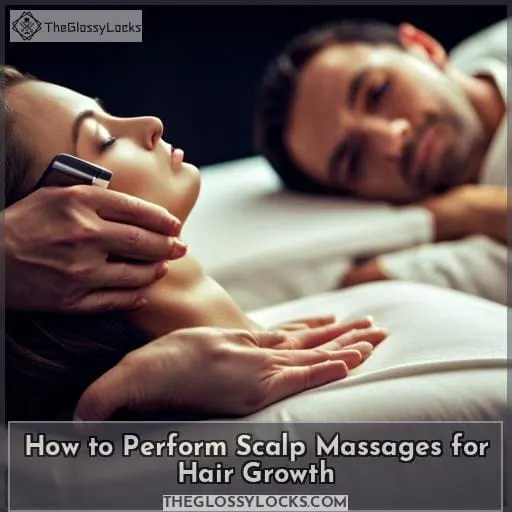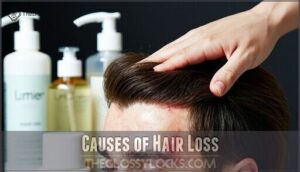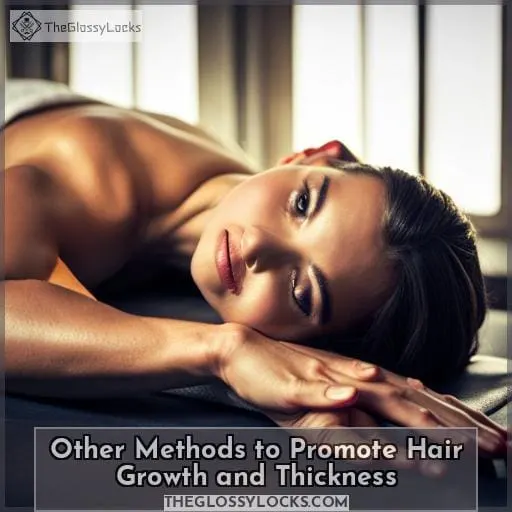This site is supported by our readers. We may earn a commission, at no cost to you, if you purchase through links.
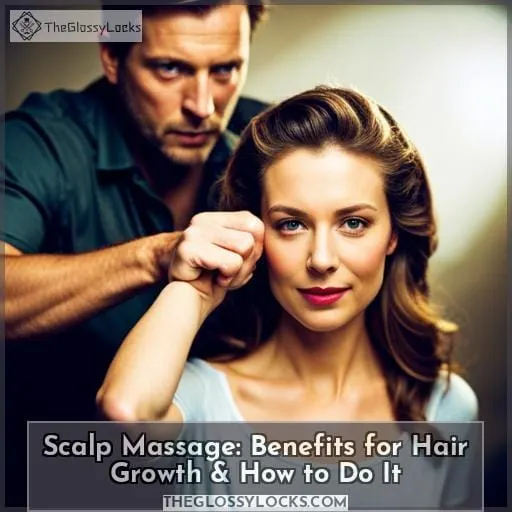 Have you ever wanted to experience the calming and healing effects of a scalp massage? Well, you’re in luck! Scalp massages are not only relaxing but also have an array of benefits for promoting hair growth.
Have you ever wanted to experience the calming and healing effects of a scalp massage? Well, you’re in luck! Scalp massages are not only relaxing but also have an array of benefits for promoting hair growth.
From increasing blood flow to stimulating hair follicles, regular scalp massages can make your locks look thicker and fuller. Additionally, they reduce stress hormones, help relieve headaches, and relax tight muscles – making them an excellent way to practice self-care.
Learn how to do it right with this guide on all the benefits that come along with giving yourself a scalp massage.
Table Of Contents
Key Takeaways
- Scalp massages have calming and healing effects.
- Regular scalp massages make hair look thicker and fuller.
- Scalp massages reduce stress hormones, relieve headaches, and relax tight muscles.
- Essential oils like lavender and peppermint oil can enhance the massage experience.
Scalp Massage for Hair Growth
You may have heard that scalp massage can help promote hair growth and thickness. Traditional scalp massages involve using fingertips to apply light to medium pressure in small circles, while you can also stimulate your scalp by gently massaging it during shampooing or with specialized tools like brushes or handheld rubber massagers.
Additionally, essential oils such as lavender and peppermint oil can be used in combination with the massage for a more relaxing experience.
Traditional Scalp Massage
You can use your fingertips to apply light to medium pressure in small circles on your scalp, stimulating the cells of hair follicles for thicker hair. Traditional techniques include applying gentle pressure with fingertips or palms, using massage tools such as brushes or handheld rubber massagers, adding essential oils like lavender and peppermint oil, and massaging while washing the hair.
These traditional methods may support relaxation, reduce stress hormones, increase blood flow and nutrition delivery to the scalp – all helping promote healthy regrowth of lost hairs.
Massage While Washing Hair
Massaging your head while washing can help boost hair regrowth and nourish the scalp. Shampooing tips, such as using a mild shampoo or conditioner, coupled with gentle scalp brushing and massaging techniques, will ensure optimum results when combined with beneficial oils like lavender oil or peppermint oil for added nourishment.
Scientific evidence suggests that using your fingertips to massage the scalp in small circles stimulates blood flow, promoting thicker hair strands.
The takeaway? Incorporating regular head massages into an overall healthy haircare routine could potentially stimulate growth – so why not give it a try today?
Brushes and Massage Tools
Try using a handheld rubber massager or special brushes to invigorate your scalp and help promote hair growth.
Brush types can range from soft-bristled tools for gentle stimulation, to medium-firm bristle massage brushes that may be used in combination with oils like lavender oil or peppermint oil for scalp oiling.
Massage duration should not exceed 6 minutes each time, and pressure techniques should vary depending on the individual’s preference.
Traditional scalp massage involves light to medium pressure applied in small circles while professional treatments such as laser therapy have more immediate effects thanks to their deeper penetration into the skin layers beneath the surface of the head.
Special tools like handheld massagers are also effective at increasing blood flow which helps dilate blood vessels and potentially reduce heart rate; something beneficial especially if you suffer from migraines or tension headaches!
All these factors combined can lead to better overall well-being while helping improve hair growth – so why not give it a try today?
Scalp Massage With Essential Oils
By incorporating essential oils into your scalp massage, you can enjoy the relaxation benefits while stimulating hair growth. Essential oils like lavender or peppermint have been found to reduce stress hormones and promote blood flow to the scalp.
Both of these benefits are beneficial for hair follicles. Research in The British Journal of Dermatology suggests that massaging with these aromatic oils may help improve symptoms of androgenic alopecia.
Peppermint oil has even been shown in an International Journal Of Women’s Health study to strengthen hair strands, making them thicker over time! With regular use, a combination of massage tools and essential oils could potentially be used as an effective treatment against hereditary baldness or thinning locks due to age-related changes.
How Scalp Massages Stimulate Hair Growth
You may be wondering how scalp massages can stimulate hair growth. Scalp massages are believed to stretch the cells of the hair follicles, potentially causing them to produce thicker and longer strands of hair.
Additionally, it is thought that regular scalp massage increases blood flow to the scalp, which in turn promotes healthier and stronger strands of hair.
Stretching Hair Follicle Cells
Stimulate hair growth and thickness by stretching the cells of your hair follicles with small circles of light to medium pressure. Scalp massages are a great way to promote cell health and increase blood circulation in the scalp, which can lead to increased follicle growth.
You can use massage tools like brushes or handheld rubber scalp massagers for maximum effect, or simply massage your head while washing it.
With regular sessions lasting no more than 6 minutes each day, you should see results over time if done consistently correctly – keep in mind that good habits will always benefit the overall healthiness of your hair! By improving blood flow through gentle manipulation on different parts of the scalp at least twice a week using these tips as guidelines, you’ll soon have thicker strands thanks to this simple yet effective technique: stretching those precious hair cells with careful attention from yourself every day.
Increasing Blood Flow to the Scalp
You can increase blood flow to your scalp with regular massages, resulting in stronger and healthier hair. Massaging your head helps dilate the tiny blood vessels below the surface of your skin while stimulating follicle cells that promote new growth.
Using light-to-medium pressure from fingertips or palms creates a soothing sensation as you move hands around different parts of the scalp for up to six minutes each day.
By doing this regularly, you may experience benefits such as:
- Minoxidil (Rogaine) effectiveness increases when used along with a massage routine.
- Improved circulation leads to longer strands and improved health overall.
- Increased levels of biotin, zinc, and iron due to increased absorption via massage.
Using techniques like these may also help reduce stress hormones like cortisol while lowering heart rate if done correctly – even healthy females have noted their resting heart rate dropped after just one session! With consistent practice over time combined with other treatments such as laser therapy or medications like finasteride and minoxidil, achieving thicker hair is possible without having an invasive procedure done by professionals.
Additional Benefits of Scalp Massages
Are you seeking more benefits from scalp massages than just hair growth? Scalp massage has a range of positive effects, including relaxation and stress reduction, relief from headaches, and a decrease in stress hormones.
Relaxation and Stress Reduction
Moreover, scalp massages can offer a soothing escape from daily pressures and help you unwind. Massage tools like brushes or handheld rubber massagers are used to target specific areas of the scalp. This helps reduce stress hormones, such as cortisol, caused by emotional or environmental stressors in life events.
Scalp massage can also provide relief for migraines and tension headaches while promoting blood flow within the head. This may contribute to healthier hair growth and prevent hair loss due to breakage from styling products or anti-acne drugs.
Additionally, regular scalp massage sessions have been reported by some people with alopecia as helpful for regrowth of their strands. It is important when seeking out any type of treatment for your hair that you consult with a doctor first.
Headache Relief
By engaging in regular scalp massages, you can reduce your tension headaches and even provide relief for migraines. One study found that up to 77% of participants experienced a reduction in their headache symptoms.
Scalp massage relieves stress hormones like cortisol, lowers heart rate and blood pressure, boosts blood flow throughout the head, and relaxes tight hairstyles, which may contribute to hair loss.
You can address hair loss through over-the-counter medication or prescription medications such as minoxidil (Rogaine) or finasteride (Propecia). Massages also boost hair growth, with results showing thicker strands due to stretching cells of the hair follicle stimulating them for increased production.
Ultimately, scalp massages are an effective way to promote relaxation while potentially addressing thinning locks.
Lowering Stress Hormones
Scalp massages can help you lower stress hormones like cortisol, reducing heart rate and blood pressure for improved relaxation. Massaging the scalp not only increases circulation to hair follicles but also helps balance cortisol levels in your body.
Animal studies have found that regular scalp massage may reduce stress while promoting hair growth and thickness with no side effects reported. Special tools like brushes or handheld rubber massagers are helpful when using a massage technique on the head, as well as essential oils for added benefits to improve scalp health.
Research has shown that even with autoimmune diseases such as alopecia, daily treatments of these relaxing rituals can lead to better results than just over-the-counter medications alone in terms of regrowth and thickness of strands! With regular practice, one’s overall wellbeing will be enhanced significantly through improved mental clarity and increased alertness without feeling exhausted from elevated stress levels – all thanks to a simple yet powerful treatment: Scalp Massage!
How to Perform Scalp Massages for Hair Growth
If you’re looking to promote hair growth, scalp massages may provide a helpful solution. To get the most out of your massage routine, use your fingertips or palms to apply light-to-medium pressure in circular motions over different areas of the scalp for 6 minutes each day.
Using Fingertips or Palms
To maximize the benefits of scalp massage, use your fingertips or palms to apply light to medium pressure in small circles on different parts of your head. This technique is suitable for all hair types and can be used with traditional oils like olive oil or coconut oil, as well as specialized massage oils that contain herbal extracts.
- Warm up the area by gently massaging it with both hands.
- Apply pressure using either fingertips or palms.
- Massage each part of the scalp for several minutes.
- Use essential oils such as lavender and peppermint if desired.
- Rinse off any excess product after completing the massage.
Studies have found that daily scalp massages may help support healthy hair growth in people suffering from alopecia areata and pattern baldness, though more research is needed into their efficacy against these conditions.
Applying Light to Medium Pressure
Apply gentle to medium pressure with your fingertips or palms in small circles on the scalp for several minutes, allowing the massage oils and essential oils to work their magic.
Not only can light pressure help promote hair growth, but a scalp massage also has additional benefits such as stress relief and tension reduction.
To maximize these effects, consider incorporating twice-daily scalp massages into your routine. Additionally, you may want to use tools like a brush massager or handheld rubber massagers for added convenience when performing this treatment.
The primary sources of evidence supporting the benefits of scalp massages are limited; however, they do show promise in promoting healthy hair growth while reducing stress hormones like cortisol, which may lead to thicker strands over time!
If you decide that trying out this technique is right for you, make sure not to forget about preventative measures – avoiding excessive shampooing/brushing & chemical treatments, as well as maintaining good nutrition by eating foods high in zinc, iron, & biotin – all things that have been shown to contribute positively towards overall health & wellness!
Circular Motions on Different Scalp Areas
Gently move your fingertips or palms in small circles on different parts of your head for 6 minutes, 1 to 2 times a day, and feel the tension melt away as you massage.
Different oil types can be used to suit individual needs – such as lavender or peppermint oils – while brushing techniques should avoid excessive shampooing and chemical treatments. Additionally, specific instructions may vary depending on hair care products that are being used, so it’s important to read all directions carefully before beginning any treatment regimen.
Causes of hair loss can include low levels of zinc or iron deficiency; ensure proper nutrition is maintained for healthy growth! Enjoy relaxing benefits like lowered stress hormones (cortisol), improved circulation in the scalp area which may contribute towards thicker strands & more manageable tresses over time – without worrying about potential side effects from medications like Minoxidil (Rogaine) & finasteride (Propecia).
Lastly, consult with a doctor if necessary and enjoy this special time devoted solely towards improving wellbeing through positive self-care practices!
Causes of Hair Loss
Hair loss can be a symptom of various underlying conditions, such as genetics and aging, hormonal factors, autoimmune diseases, and medications. It’s important to understand the potential causes of hair loss in order to take appropriate steps towards preventing it or managing its symptoms.
Genetics may play a role in determining why some people experience balding more than others; certain hormonal imbalances like hypothyroidism can also lead to thinning hair; finally, autoimmune diseases such as Alopecia Areata are known for causing rapid patchy baldness.
Medications like chemotherapy drugs or oral contraceptives may cause temporary shedding too.
Genetics and Aging
Genetics and aging can play a major role in hair loss, often making it feel like you’re running uphill against an unstoppable force—like trying to stop the tide from coming in with your bare hands. Hair loss can be attributed to genetic factors or hormone levels, as well as various life stages of scalp health.
While a small-scale study has shown that scalp massages may lead to thicker hair growth, research published in peer-reviewed scientific journals is still limited on this topic.
Nutritional deficiencies such as zinc and iron lack may also contribute towards thinning locks; however, prescription medication such as finasteride (Propecia) has been proven effective for treating hereditary baldness at the back of the head.
If other symptoms are present along with hair loss, then consulting a doctor should not be delayed for proper diagnosis and treatment plan according to individual needs.
Hormonal Factors
Hormones can also affect hair growth, so it’s important to keep an eye on your hormone levels and see a doctor if you notice any changes. Hormonal imbalance is one of the most common causes of hair loss, especially in women.
Stress hormones like cortisol can contribute to scalp conditions that result in thinning hair or baldness. Nutrient deficiencies, the use of chemical treatments, and other factors may also lead to various forms of alopecia areata or patterned balding.
A 4-minute scalp massage has been shown through diverse studies to help reduce stress hormones while stimulating blood flow throughout the head for healthier locks overall. However, due to its limited evidence base, more research is needed before any conclusions can be made about its efficacy for promoting thicker strands over time.
Autoimmune Diseases and Medications
Certain medications and autoimmune diseases can also cause hair loss, so it’s important to talk to your doctor about any potential causes. Autoimmune conditions such as lupus or alopecia areata may impact the scalp’s health and lead to thinning strands.
Certain medications used for high blood pressure, depression, and cancer treatments have been known to contribute too.
At the end of the study, survey responses revealed limited evidence that a 4-minute scalp massage could reduce stress hormones while stimulating blood flow throughout the head for healthier locks overall.
However, more research is needed before conclusions can confidently be made regarding its efficacy in promoting thicker strands over time, given privacy policy considerations at play here too.
Other Methods to Promote Hair Growth and Thickness
If you are looking for ways to promote hair growth and thickness, there are several methods worth considering. Prescription medications such as finasteride (Propecia) and minoxidil (Rogaine) can be prescribed by your doctor to help with hair loss.
Over-the-counter treatments like certain shampoos may also stimulate regrowth in some cases. Finally, preventative hair care practices such as avoiding excessive brushing or styling tools can keep your scalp healthy and reduce breakage of existing hairs.
Prescription Medications
Prescription medications, such as finasteride (Propecia) and minoxidil (Rogaine), are commonly used to treat hair loss in men.
It’s important to take a closer look at hormone levels, zinc levels, iron levels, and other health conditions that may cause hair damage or thinning before seeking out prescription drugs.
Laser therapy is another popular option for treating baldness, which has been extensively studied by academic institutions across the world with positive results.
Finasteride works by blocking the main ingredient responsible for converting testosterone into dihydrotestosterone, which can lead to male pattern baldness when present in excess quantities.
Minoxidil helps stimulate new growth within existing follicles while also increasing blood flow around them, promoting thicker strands over time if used regularly according to your doctor’s instructions.
To prevent further damage or early signs of thinning, it’s best practice to incorporate scalp massages along with a healthy diet and lifestyle changes into your routine.
Over-the-Counter Treatments
Over-the-counter treatments, like minoxidil and certain shampoos, can help stimulate hair growth when used regularly. Medicated shampoo containing ketoconazole may reduce the amount of dandruff on the scalp and decrease inflammation that contributes to hair loss.
Minoxidil use is effective for both men and women with hereditary baldness at the back of their heads.
Laser therapy has been extensively studied by academic institutions across the world with positive results but should be done in a professional setting such as a dermatologist’s office or medical spa to ensure safety protocols are followed properly.
Hair transplants involve surgically moving healthy follicles from one area of your head to another, while corticosteroid injections directly into affected areas may slow down further damage caused by alopecia areata (spot baldness).
Crash diets, hormonal changes due to aging or stress levels recommended by governmental agencies such as the American Academy Of Dermatology can lead to less hair loss over time if managed correctly, along with regular use of OTC products designed specifically for promoting new growth.
Preventative Hair Care Practices
To keep your hair healthy and prevent breakage, it’s important to follow a tailored hair care routine. For instance, making changes to daily habits may lead to improved hair loss, like the 69 percent of participants in one study reported.
- Nutrition deficiencies, such as low levels of zinc or iron, can contribute significantly.
- Laser therapy is an effective treatment in professional settings that can help reduce thinning strands over time.
- Hair transplants and corticosteroid injections have also been used successfully for alopecia cases where scalp massages cannot address the issue alone.
Regularly checking in with your stylist or dermatologist will ensure you maintain a regimen that works best for you and keeps your locks looking their finest!
Frequently Asked Questions (FAQs)
Are scalp massages safe?
Yes, scalp massages are generally safe. However, use gentle pressure and avoid vigorous massage to prevent hair breakage. Employing the power of imagery can help you relax while stimulating your scalp for optimal results.
Can scalp massages be done on a daily basis?
Yes, daily scalp massages are possible! With the correct technique and essential oils, they can help encourage blood flow to the scalp and stimulate healthy hair growth.
Are there any side effects associated with scalp massages?
No need to worry – scalp massages are generally safe. As the saying goes, ‘no pain, no gain’, but with scalp massages that’s not true. Apart from occasional discomfort related to the pressure applied during a massage, there are no known side effects or risks associated with this practice.
Is there any evidence to suggest that scalp massages can prevent hair loss?
Research suggests that scalp massages may help reduce hair loss and promote thickness. Studies have found improved hair growth in participants after regular massage sessions. Scalp massages can improve blood flow, stretch cells of the follicles, and stimulate regrowth with essential oils like lavender or peppermint.
Preventive care practices are also important to keep your locks healthy and strong.
Can scalp massages be used in conjunction with other hair growth treatments?
Yes, scalp massages may be used in conjunction with other treatments to help promote healthy hair growth. Imagine a luxurious spa day for your locks, enjoying the relaxing effects of massage as well as nourishing products that give life back to tired strands.
With this combination, you can reap the benefits of both natural and modern solutions for achieving beautiful tresses.
Conclusion
You may be wondering if scalp massages really can help your hair grow thicker and longer. The truth is that there is limited evidence on this, but the potential benefits are promising.
Studies have shown that scalp massages can help promote blood flow and stimulate the cells of hair follicles, which could lead to thicker, healthier hair. Additionally, scalp massages can help reduce stress hormones, relax the body, and relieve headaches, making it an all-around beneficial and therapeutic activity.
While scalp massages alone may not be enough to prevent hair loss, they can be a great addition to existing treatments and prevention methods.

